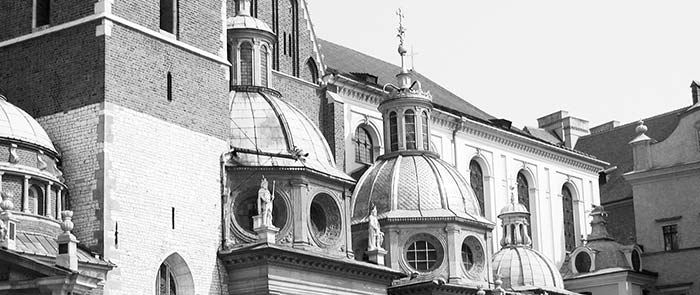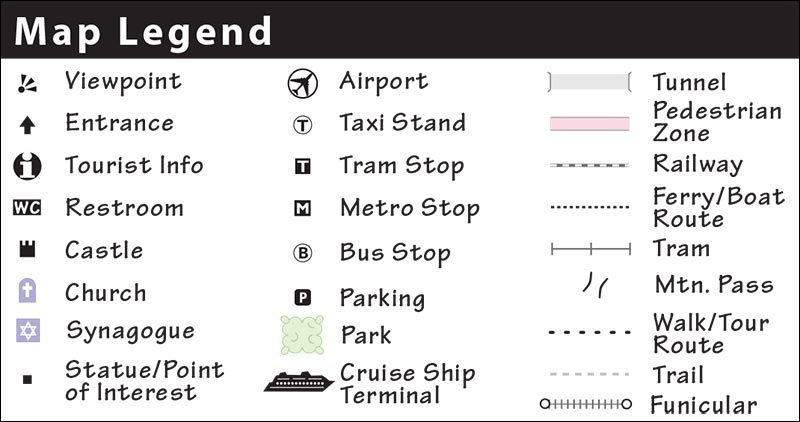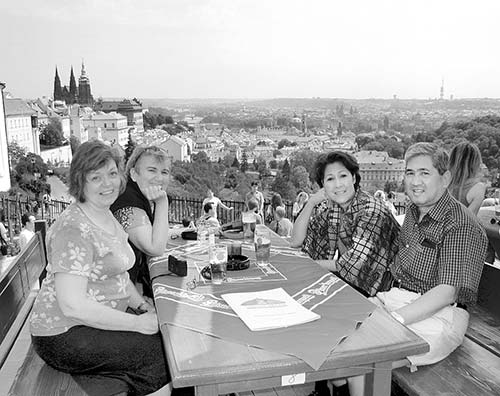
Map: Top Destinations of Eastern Europe
Traveling as a Temporary Local
Until 1989, Eastern Europe was a foreboding place—a dark and gloomy corner of the “Evil Empire.” But the dismal grays and preachy reds of communism live on only in history books, museums, and kitschy theme restaurants. Today’s Eastern Europe is a traveler’s delight, with friendly locals, lively squares, breathtaking sights, fascinating history, reasonable prices, and a sense of pioneer excitement.
Wander among Prague’s dreamy, fairy-tale spires, bask in the energy of Kraków’s Main Market Square, and soak with chess players in a Budapest bath. Ponder Europe’s most moving Holocaust memorial at Auschwitz. Enjoy nature as you glide across Lake Bled to a church-topped island in the shadow of the Julian Alps. Taste a proud Hungarian vintner’s wine and say, “Egészségedre!” (or stick with “Cheers!”).
This book covers Eastern Europe’s top big-city, small-town, and back-to-nature destinations—from the Hungarian metropolis of Budapest to the quaint Czech village of Český Krumlov to the pristine Julian Alps of Slovenia. It then gives you all the specifics and opinions necessary to wring the maximum value out of your limited time and money. If you’re planning for a month or less in this region, this book is all you need.
Experiencing Europe’s culture, people, and natural wonders economically and hassle-free has been my goal for several decades of traveling, tour guiding, and writing. With this book, I pass on to you all the lessons I’ve learned.
I’ve been selective, including only the top destinations and sights. For example, Poland has dozens of medieval castles—but Malbork is a cut above the rest. The best is, of course, only my opinion. But after spending much of my life exploring and researching Europe, I’ve developed a sixth sense for what travelers enjoy. Just thinking about the places featured in this book makes me want to polka.

Use this legend to help you navigate the maps in this book.
Rick Steves Eastern Europe is a personal tour guide in your pocket. Better yet, it’s actually two tour guides in your pocket: The co-author of this book is Cameron Hewitt. Cameron writes and edits guidebooks for my travel company, Rick Steves’ Europe. Inspired by his Polish roots and by the enduring charm of the Eastern European people, Cameron has spent the last decade closely tracking the exciting changes in this part of the world. Together, Cameron and I keep this book up to date and accurate (though for simplicity we’ve shed our respective egos to become “I” in this book).
Eastern Europe is a sprawling region; a comprehensive guidebook would span many volumes. To keep things simple and focused, this book covers the best of Eastern Europe in three sections.
The core countries of the Czech Republic, Poland, Hungary, and Slovenia—where most travelers focus their time—receive full coverage.
I’ve also included full coverage for two important gateway cities: Vienna, Austria, and Bratislava, Slovakia. While there’s not room in this book to cover other destinations in those countries, you’re likely to pass through these capitals on your way between the major core destinations.
The “More Eastern Europe” section, near the back of the book, is a roundup of other countries in this area that may serve as logical add-ons. These include Croatia, Bosnia-Herzegovina, Montenegro, Bulgaria, and Romania. (Some of these are covered in greater depth in separate guidebooks—such as Rick Steves Croatia & Slovenia.)
For places with full coverage, each destination is organized as a minivacation on its own, filled with exciting sights, strollable neighborhoods, affordable places to stay, and memorable places to eat. In the core-country chapters, you’ll find these sections:
Planning Your Time suggests a schedule for how to best use your limited time.
Orientation has specifics on public transportation, helpful hints, local tour options, easy-to-read maps, and tourist information.
Sights describes the top attractions and includes their cost and hours. Major sights have self-guided tours.
Self-Guided Walks take you through interesting neighborhoods, pointing out sights and fun stops.
Sleeping describes my favorite hotels, from good-value deals to cushy splurges.
Eating serves up a range of options, from inexpensive eateries to fancy restaurants.
Connections outlines your options for traveling to destinations by train, bus, and boat. For car-friendly regions, I’ve included route tips for drivers, with recommended roadside attractions along the way.
Country Introductions give you an overview of each country’s culture, customs, money, history, current events, cuisine, language, and other useful practicalities.
The Practicalities chapter near the end of this book is a traveler’s tool kit, with my best advice about money, sightseeing, sleeping, eating, staying connected, and transportation (trains, buses, boats, car rentals, driving, and flights).
The appendix has the nuts and bolts: useful phone numbers and websites, a festival list, recommended books and films, a climate chart, a handy packing checklist, and a guide to pronouncing Eastern European place names.
Throughout this book, you’ll find money- and time-saving tips for sightseeing, transportation, and more. Some businesses—especially hotels and walking tour companies—offer special discounts to my readers, indicated in their listings.
Browse through this book, choose your favorite destinations, and link them up. Then have a great trip! Traveling like a temporary local, you’ll get the absolute most of every mile, minute, and dollar. I’m happy that you’ll be meeting some of my favorite Europeans as you visit places I know and love.
This section will help you get started on planning your trip—with advice on trip costs, when to go, and what you should know before you take off.
Your trip to Europe is like a complex play—it’s easier to follow and fully appreciate on a second viewing. While no one does the same trip twice to gain that advantage, reading this book before your trip accomplishes much the same thing.
Design an itinerary that enables you to visit sights at the best possible times. Note festivals, holidays, specifics on sights, and days when sights are closed (all covered in this book). For example, most museums throughout Eastern Europe close on Mondays. Hotels in resort towns (such as those in the Julian Alps) are most crowded on Fridays and Saturdays, whereas weekdays are tight in convention cities (for instance, Budapest and Warsaw). Expect seasonal closures. To connect the dots smoothly, read the tips in Practicalities on taking trains and buses or renting a car and driving. Designing a smart trip is a fun, doable, and worthwhile challenge.
Make your itinerary a mix of intense and relaxed stretches. To maximize rootedness, minimize one-night stands. It’s worth taking a long drive after dinner (or a train/bus ride with a dinner picnic) to get settled in a town for two nights. Every trip—and every traveler—needs slack time (laundry, picnics, people-watching, and so on). Pace yourself. Assume you will return.
Reread this book as you travel, and visit local tourist information offices (abbreviated as TI in this book). Upon arrival in a new town, lay the groundwork for a smooth departure; confirm the train, bus, boat, or road you’ll take when you leave.
Even with the best-planned itinerary, you’ll need to be flexible. Update your plans as you travel. Get online or call ahead to learn the latest on sights (special events, tour schedules, and so on), book tickets and tours, make reservations, reconfirm hotels, and research transportation connections.
Enjoy the friendliness of the local people. Connect with the culture. Set up your own quest for the best bit of communist kitsch, mug of Czech beer, bowl of borscht, or scenic seafront perch. Slow down and be open to unexpected experiences. Ask questions—most locals are eager to point you in their idea of the right direction. Keep a notepad in your pocket for confirming prices, noting directions, and organizing your thoughts. Wear your money belt, learn the currency, and figure out how to estimate prices in dollars. Those who expect to travel smart, do.
The countries in this book—more than two decades removed from communism—are no longer Europe’s bargain basement. Although the global recession hit their economies along with everyone else’s, the cost of living in most of Eastern Europe is approaching what it is in the West. But it can still be a good value to travel here. Things that natives buy—such as food and transportation—remain fairly inexpensive. Hotels can be pricey, but if you use my listings to find the best accommodations deals, a trip to these countries can be substantially cheaper than visiting, say, Italy, Germany, or France.
Five components make up your trip costs: airfare to Europe, transportation in Europe, room and board, sightseeing and entertainment, and shopping and miscellany. The prices I’ve listed below are more or less average for all of the destinations in this book. Prices are generally lower in Poland and higher in Slovenia and Vienna; the Czech Republic and Hungary are in between. Of course, big cities (such as Prague and Budapest) are much more expensive than smaller towns (like Český Krumlov and Eger).
Airfare to Europe: A basic round-trip flight from the US to Prague can cost, on average, about $1,000-2,000 total, depending on where you fly from and when (cheaper in winter). Consider saving time and money in Europe by flying into one city and out of another; for instance, flying into Prague and out of Vienna is almost certainly cheaper than the added expense (and wasted time) of an overland return trip to Prague. Overall, Kayak.com is the best place to start searching for flights on a combination of mainstream and budget carriers.
Transportation in Europe: For a three-week whirlwind trip of my recommended destinations by public transportation, allow $300 per person. If you plan to rent a car, allow $230 per week, not including tolls, gas, and supplemental insurance. Car rentals are cheapest if arranged from the US. Rail passes normally must be purchased outside Europe but aren’t necessarily your best option—you may save money simply by buying tickets as you go. Don’t hesitate to consider flying—a short flight can be cheaper than the train (check www.skyscanner.com for intra-European flights). For more on public transportation and car rental, see “Transportation” in Practicalities.
Room and Board: You can thrive in Eastern Europe on $100 a day per person for room and board. This allows $15 for lunch, $25 for dinner, and $60 for lodging (based on two people splitting the cost of a comfortable $120 double room that includes breakfast). Students and tightwads can enjoy Eastern Europe for as little as $50 a day ($30 per hostel bed, $20 for groceries and snacks).
Sightseeing and Entertainment: Sightseeing is cheap here. Figure $3-6 per major sight (with some more expensive sights at around $10), and $10-25 for splurge experiences (e.g., going to concerts, taking a lake cruise, or soaking in a Budapest bath). You can hire your own private guide for four hours for about $100-150—a great value when divided among two or more people. An overall average of $20 a day works for most people. Don’t skimp here. After all, this category is the driving force behind your trip—you came to sightsee, enjoy, and experience Eastern Europe.
Shopping and Miscellany: Figure $2 per postcard, coffee, beer, and ice-cream cone. Shopping can vary in cost from nearly nothing to a small fortune. Good budget travelers find that this category has little to do with assembling a trip full of lifelong memories.
So much to see, so little time. How to choose? Depending on the length of your trip, assuming you are focusing on the core countries, and taking geographic proximity into account, here are my recommended priorities.
This includes nearly everything on the map on here. If you don’t have time to see it all, prioritize according to your interests. The “Eastern Europe a Glance” sidebar can help you decide where to go (here). The three-week itinerary (see sidebar) includes all of the stops in the first 20 days.
With more time—or for a different focus to your trip—consider some of the neighboring countries. See the “More Eastern Europe” section near the end of this book for ideas on how to splice in Croatia, Bosnia-Herzegovina, Montenegro, Bulgaria, and Romania.
The “tourist season” runs roughly from May through September. Summer has its advantages: the best weather, very long days (light until after 21:00), and the busiest schedule of tourist fun.
In spring and fall—May, June, September, and early October—travelers enjoy fewer crowds and milder weather. This is my favorite time to travel here. Cities are great at this time of year, but some small towns get quieter and quieter the further off-season you get, and are downright deserted and disappointing in early May and late October.
Winter travelers find concert season in full swing, with absolutely no tourist crowds (except in always-packed Prague), but some accommodations and sights are either closed or run on a limited schedule. Confirm your sightseeing plans locally, especially when traveling off-season. The weather can be cold and dreary, and night will draw the shades on your sightseeing before dinnertime. (For more information, see the climate chart in the appendix.)
Check this list of things to arrange while you’re still at home.
You need a passport—but no visa or shots—to travel in the countries covered in this book. You may be denied entry into certain European countries if your passport is due to expire within six months of your ticketed date of return. Get it renewed if you’ll be cutting it close. It can take up to six weeks to get or renew a passport (for more on passports and requirements for Eastern European countries, see www.travel.state.gov). Pack a photocopy of your passport in your luggage in case the original is lost or stolen.
Book rooms well in advance if you’ll be traveling during peak season (July and August in resort towns, September and October in convention cities), or over any major holidays or festivals (see list on here).
Call your debit- and credit-card companies to let them know the countries you’ll be visiting, to ask about fees, and to request your PIN if you don’t already know it. See here for details.
Do your homework if you’re considering travel insurance. Compare the cost of the insurance to the cost of your potential loss. Also, check whether your existing insurance (health, homeowners, or renters) covers you and your possessions overseas. For more tips, see www.ricksteves.com/insurance
If you’re taking an overnight train and need a couchette or sleeper—and you must leave on a certain day—consider booking it in advance through a US agent (such as www.ricksteves.com/rail), even though it may cost more than buying it in Europe. If you’re planning on renting a car, bring your driver’s license and an International Driving Permit (see here). Confirm pickup hours; many car-rental offices close Saturday afternoon and all day Sunday. Many countries require drivers to buy a toll sticker for driving on expressways; for details per country, see here.
If you plan to visit the Auschwitz-Birkenau Concentration Camp Memorial, you’re required to reserve ahead on their website (see here). You’ll want to do this as far ahead as you can set a date.
If you’d like to tour the Hungarian Parliament in Budapest, consider reserving online a few days ahead to ensure your choice of entrance time (see here).
If you plan on visiting Schönbrunn Palace in Vienna during the summer or on a weekend, make a reservation in advance (see here).
If you plan to hire a local guide, reserve ahead by email. Popular guides can get booked up.
If you’re bringing a mobile device, consider signing up for an international plan for cheaper calls, texts, and data (see here). Download any apps you might want to use on the road, such as translators, maps, transit schedules, and Rick Steves Audio Europe (see sidebar).
Updates to This Book: Check www.ricksteves.com/update.
We travel all the way to Europe to enjoy differences—to become temporary locals. You’ll experience frustrations. Certain truths that we find “God-given” or “self-evident,” such as cold beer, ice in drinks, bottomless cups of coffee, “the customer is king,” and bigger being better, are suddenly not so true. One of the benefits of travel is the eye-opening realization that there are logical, civil, and even better alternatives. A willingness to go local ensures that you’ll enjoy a full dose of European hospitality. And with an eagerness to go local, you’ll have even more fun.

Fortunately for you, hospitality is a local forte. The friendliness of the Eastern Europeans seems to have only been enhanced during the communist era: Tangible resources were in short supply, so an open door and a genial conversation were all that people had to offer. For many Eastern Europeans, the chance to chat with an American is still a delightful novelty. Even so, some people—hardened by decades of being spied on by neighbors and standing in long lines to buy food for their family—seem brusque at first. In my experience, all it takes is a smile and a little effort to befriend these residents of the former “Evil Empire.”
Europeans generally like Americans. But if there is a negative aspect to the image of Americans, it’s that we are loud, wasteful, ethnocentric, too informal (which can seem disrespectful), and a bit naive.
While Europeans look bemusedly at some of our Yankee excesses—and worriedly at others—they nearly always afford us individual travelers all the warmth we deserve.
Judging from all the happy feedback I receive from travelers who have used this book, it’s safe to assume you’ll enjoy a great, affordable vacation—with the finesse of an independent, experienced traveler.
Thanks, and happy travels!
